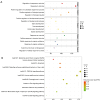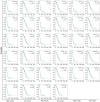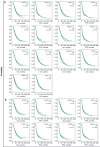Identification of genes predicting chemoresistance and short survival in ovarian cancer
- PMID: 39262489
- PMCID: PMC11385244
- DOI: 10.21037/tcr-23-2157
Identification of genes predicting chemoresistance and short survival in ovarian cancer
Abstract
Background: Ovarian cancer (OC) is a kind of lethiferous cancer in gynecology, and the development of chemoresistance is the brief reason for treatment failure. The genes which contribute to chemoresistance are often leading to short survival. Thus, this study aims to identify predictive markers for chemoresistance and survival from chemoresistant-related genes.
Methods: Coremine was used to retrieve of genes linked to OC chemoresistance. The relationship of genes with patient survival was analyzed in 489 OC patients of The Cancer Genome Atlas (TCGA) cohort, which the subgroup of 90 resistant and 197 sensitive samples was used to determine gene expression. Kaplan-Meier (KM) plotter of 1,816 OC patients with survival data was retrieved for survival analysis. Survival analysis was carried out by the R survival package in R (version 3.3.1). KM and receiver operating characteristic (ROC) curve were respectively used to access the ability of a gene to predict survival and chemoresistance.
Results: In this study, a group of genes potentially linked to OC chemoresistance was identified, which dysregulated in 90 chemoresistant tissues compared with 197 sensitive tissues. Of them, thirteen genes could predict chemoresistance in 1,347 patients, especially SOS1, MSH6, STAT5A were excellent for predicting chemoresistance to any drugs, platin and taxane, CASP2 and PARD6B for any drugs and platin, and HSP90AA1 and HSP90B1 for taxane. Meanwhile, 44 genes linked to OC chemoresistance could predict short overall survival (OS) and/or disease-free survival (DFS) in 489 OC patients, and 10 of them could predict short OS in large cohort of up to 1,657 patients. Finally, it is noteworthy that CASP2 was down-regulated in 90 chemoresistant samples, and low expression of the gene predicted chemoresistance in 1,347 patients, short OS and DFS in 489 patients, and short OS and progression-free survival (PFS) in 1,657 patients.
Conclusions: The identified genes specifically the CASP2 might be potentially used as predictive marker, prognostic marker and therapeutic target in management of OC.
Keywords: Ovarian cancer (OC); chemoresistance; predictive markers.
2024 Translational Cancer Research. All rights reserved.
Conflict of interest statement
Conflicts of Interest: All authors have completed the ICMJE uniform disclosure form (available at https://tcr.amegroups.com/article/view/10.21037/tcr-23-2157/coif). The authors have no conflicts of interest to declare.
Figures





Similar articles
-
Cross-validation of genes potentially associated with overall survival and drug resistance in ovarian cancer.Oncol Rep. 2017 May;37(5):3084-3092. doi: 10.3892/or.2017.5534. Epub 2017 Mar 27. Oncol Rep. 2017. PMID: 28350120
-
A novel TCGA-validated programmed cell-death-related signature of ovarian cancer.BMC Cancer. 2024 Apr 23;24(1):515. doi: 10.1186/s12885-024-12245-2. BMC Cancer. 2024. PMID: 38654239 Free PMC article.
-
[Relationships between decreased LAMC3 and poor prognosis in ovarian cancer].Zhonghua Fu Chan Ke Za Zhi. 2021 Jul 25;56(7):489-497. doi: 10.3760/cma.j.cn112141-20210426-00230. Zhonghua Fu Chan Ke Za Zhi. 2021. PMID: 34304441 Chinese.
-
Novel players in the development of chemoresistance in ovarian cancer: ovarian cancer stem cells, non-coding RNA and nuclear receptors.Cancer Drug Resist. 2024 Feb 28;7:6. doi: 10.20517/cdr.2023.152. eCollection 2024. Cancer Drug Resist. 2024. PMID: 38434767 Free PMC article. Review.
-
Integrative data mining and meta-analysis to investigate the prognostic role of microRNA-200 family in various human malignant neoplasms: A consideration on heterogeneity.Gene. 2019 Oct 20;716:144025. doi: 10.1016/j.gene.2019.144025. Epub 2019 Aug 5. Gene. 2019. PMID: 31394177 Review.
Cited by
-
Metal-based molecules in the treatment of cancer: From bench to bedside.Oncol Res. 2025 Mar 19;33(4):759-779. doi: 10.32604/or.2024.057019. eCollection 2025. Oncol Res. 2025. PMID: 40191719 Free PMC article. Review.
References
LinkOut - more resources
Full Text Sources
Miscellaneous
